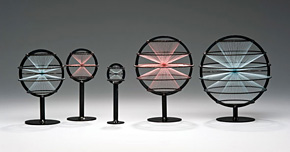Gallery: Julian Voss-Andreae
Quantum concepts you can touch
By Calla Cofield
|
"The term 'quantum object,' although regularly used in physics, is really an oxymoron. An 'object' is something that lives completely in the paradigm of classical physics. But for things that exist in the quantum realm, classical characteristics like location, defining physical characteristics, and deterministic behavior no longer apply." Julian Voss-Andreae |
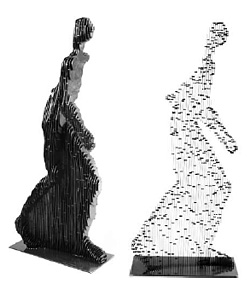 |
Last time we checked in with Julian Voss-Andreae (Feb 06 issue) the artist-turned-physicist-turned-artist was displaying a fond obsession with proteins. His science-inspired art included colorful, shiny representations of biological helixes, hemoglobin, and skin proteins.
In November 2009, he ventured back into the physics world with a new collection of artwork, Quantum Objects.
"The term 'quantum object,' although regularly used in physics, is really an oxymoron," Voss-Andreae writes on his Web site. "An 'object' is something that lives completely in the paradigm of classical physics . But for things that exist in the quantum realm, classical characteristics like location, defining physical characteristics, and deterministic behavior no longer apply."
Because a quantum object has no definite location or shape, the moment artists set out to draw or sculpt it they have already lost some of the quantum essence. Yet people continue to try, because visualization remains an important tool in understanding science. Though there is no correct way of drawing a quantum phenomenon, we can use art to stretch and explore our understanding of it.
"What I want is to increase the audience's capacity to intuit the deeper nature of reality by sensually experiencing the works," Voss-Andreae says. When he began the project he had physicists in mind, and wanted to create something they could relate to something that went beyond pure entertainment.
Voss-Andreae grew up with an interest in art, but chose to study quantum mechanics in graduate school. When he had his fill, he returned to school to earn a bachelor's degree in art.
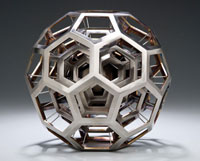 |
| Quantum Buckyball, 2009 Stainless steel 1 0" x 10" x 10" (25 cm x 25 cm x 25 cm) |
Some of the pieces in the new collection simply make standard classical representations of quantum objects more aesthetically pleasing. He certainly does this exceptionally wellfor instance, building a stainless-steel model of four concentric buckyballs, microscopic hollow spheres made of carbon molecules. "Quantum Buckyball" is a bit smaller than a soccer ball, the physical object often used to describe the look of a buckyball.
But this is something a textbook could also tackle.
Voss-Andreae goes beyond literal representation, infusing his quantum objects with philosophical interpretations. He depicts boson and fermion particles as spheres, but expands on the notion of a particle "family" by using blue and pink thread to represent different particle spins (a fundamental property that determines some particle behaviors).
The piece "Night Path" interprets Richard Feynman's technique of measuring all possible paths that a particle could take by "slicing up" segments of space-time. The result is a stunning work in which taut gold threads collectively trace a curved path inside a black box divided into equal sections. Voss-Andreae writes that the path "connects the idea of the quantum mechanical path to the image of a meteor, a rock falling through the dark of the night, often believed to be connected to a meaningful event."
Voss-Andreae takes on a final challenge by creating classical interpretations of quantum objects that artists have rarely tried to depict. How might he capture the concept of symmetry breaking, for instance, in which a system is suddenly presented with multiple possible paths, each with a different physical manifestation? Voss-Andreae uses hanging chains to represent graphs of those quantum physical possibilities. An underlying symmetry of physical laws is broken when a system chooses one of these paths.
"Quantum Corral" illustrates what happens when researchers round up iron atoms on a clean copper surface and arrange them in a circle. The atoms form a ring of peaks, while their shared electrons create a ripple pattern in the center, demonstrating their wave nature. Scientists first used a scanning tunneling microscope to both create and image a quantum corral in 1993.
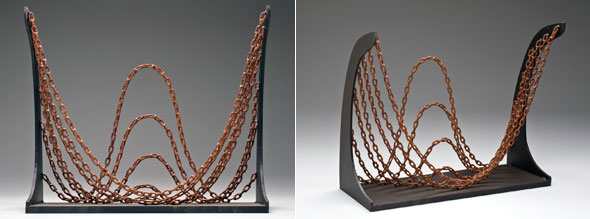 |
| Sketch for 'Symmetry Break', 2009 Steel chain and mixed media 17" x 20" x 8" (43 cm x 51 cm x 20 cm) |
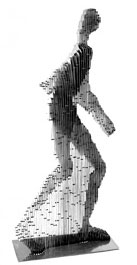 |
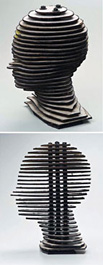 |
| Quantum Man (small version), 2007 Steel 50" x 22" x 9" (127 cm x 56 cm x 23 cm) |
Prayer (Head sketch for Quantum Woman 2), 2009 Masonite, paper, and steel hardware 14" x 11" x 10" (36 cm x 30 cm x 25 cm) |
Also included in the collection are miniature versions of Voss- Andreae's "Quantum Man" and "Quantum Woman." They are based on the quantum principle that everything with mass, from electrons and protons to Volkswagens and people, has a wavelength. If we created just the right circumstances and had eons of time, we could theoretically create a beam of people that behaved like a wave.
While that experiment isn't likely to take place any time soon, Voss-Andreae found another way to turn a person into a wave: A series of steel sheets form the image of a human when viewed from one angle, but nearly disappear when viewed from another. As in the diffraction pattern of a wave, the fronts of the plates are clearly visible, but the sculpture seems to disappear and reappear as you move past it. The sheets are uniformly separated by about two centimeters, a bit longer than the actual human de Broglie wavelength of about 10-38 meters.
You can see Quantum Objects at www.julianvossandreae.com. The collection is part of a larger exhibit titled Worlds within Worlds, on display and open to the public weekdays through April 30 at the American Center for Physics in College Park, Maryland.
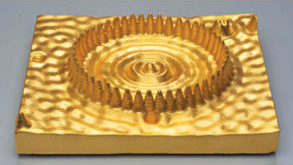 Quantum Corral, 2009 Gilded wood 13" x 12" x 3" (34 cm x 31 cm x 6 cm) |
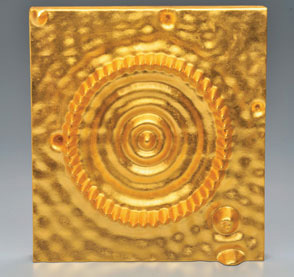 |
Click here to download the pdf version of this article.



